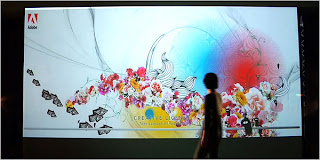 I’ve been to a couple of different events over the past month or so and I’ve noticed a very popular and prevalent topic of discussion – interactivity. With catalystic changes in technology, marketing approaches have also been under the pressure to keep up – forcing the acceleration of answering the question, “What do we do now? and how do we do it?”
I’ve been to a couple of different events over the past month or so and I’ve noticed a very popular and prevalent topic of discussion – interactivity. With catalystic changes in technology, marketing approaches have also been under the pressure to keep up – forcing the acceleration of answering the question, “What do we do now? and how do we do it?”
In the past (a long, long time ago), labeling products biggER and bettER worked. It’s obvious that times have changed and for the marketing folks out there, the difficult part is in figuring out when the old methods don’t work anymore and what new ones do. That’s the challenge. It is difficult to identify when something isn’t performing as well as it used too and that’s because naturally, humans are resistant to change. It’s in the news all the time about how so-and-so was replaced by so-and-so because so-and-so #2 did this and that. If you take a look at each so-and-so, they’re all very bright and intelligent people. It’s not that one is smarter than the other, but it seems as though one is more open to accepting the evolving nature of technology, business, marketing, culture and society.
Before I go off too far on my tangent, I read about Adobe’s new marketing tool – the interactive wall! It’s actually really neat and something I have never seen or heard of before.
Adobe will unveil an interactive wall of projected animation this morning in Union Square, along the 14th Street side of the Virgin Megastore. As pedestrians walk past the wall, infrared sensors will lock on to the person closest to the wall, who will then be able to control a projected slider button at the bottom of the wall.
Back to what I was saying, the idea of interactivity is quickly permeating the air and people are aggresively trying to figure out how to make their product, website, company etc. more so. I think marketing has finally reached a point where its focus is no longer about trying to drive consumers to the product, but instead to create some kind of incentive for them to want to go and stay at their own will. It wasn’t until I was in the developing stages of one of my web projects, I realized the power in interactivity. Print ads, commercials and radio ads have one thing in common – it’s one-wayed. The consumer has to see and hear in a one-size-fits-all kind of fashion. Where as in interactive mediums, it allows consumers to communicate in a two-way stream. Interactivity allows consumers to experience (rather than just inform) and th at’s the difference. For example, it’s kind of like buying a car. We know that BMW is a driver’s car. Everything about the car internally and externally is designed to give the driver the most amazing driving experience. How do we know this? It’s in the magazine articles, the TV commericals, the billboards by the street, but are you convinced? Maybe, but probably not until you test drive it yourself. It’s that kind of thing. We as consumers place a lot of weight on how we experience something. It’s a way to validate for ourselves whether or not something is really what it seems.
at’s the difference. For example, it’s kind of like buying a car. We know that BMW is a driver’s car. Everything about the car internally and externally is designed to give the driver the most amazing driving experience. How do we know this? It’s in the magazine articles, the TV commericals, the billboards by the street, but are you convinced? Maybe, but probably not until you test drive it yourself. It’s that kind of thing. We as consumers place a lot of weight on how we experience something. It’s a way to validate for ourselves whether or not something is really what it seems.

